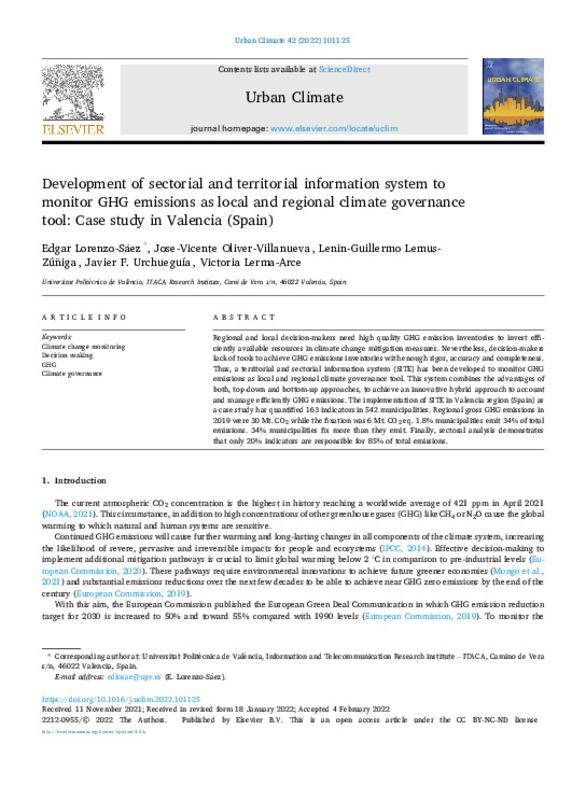JavaScript is disabled for your browser. Some features of this site may not work without it.
Buscar en RiuNet
Listar
Mi cuenta
Estadísticas
Ayuda RiuNet
Admin. UPV
Development of sectorial and territorial information system to monitor GHG emissions as local and regional climate governance tool: Case study in Valencia (Spain)
Mostrar el registro sencillo del ítem
Ficheros en el ítem
| dc.contributor.author | Lorenzo-Sáez, Edgar
|
es_ES |
| dc.contributor.author | Oliver Villanueva, José Vicente
|
es_ES |
| dc.contributor.author | Lemus Zúñiga, Lenin Guillermo
|
es_ES |
| dc.contributor.author | Urchueguía Schölzel, Javier Fermín
|
es_ES |
| dc.contributor.author | LERMA ARCE, VICTORIA
|
es_ES |
| dc.date.accessioned | 2023-07-14T18:00:50Z | |
| dc.date.available | 2023-07-14T18:00:50Z | |
| dc.date.issued | 2022-03 | es_ES |
| dc.identifier.uri | http://hdl.handle.net/10251/194983 | |
| dc.description.abstract | [EN] Regional and local decision-makers need high quality GHG emission inventories to invest efficiently available resources in climate change mitigation measures. Nevertheless, decision-makers lack of tools to achieve GHG emissions inventories with enough rigor, accuracy and completeness. Thus, a territorial and sectorial information system (SITE) has been developed to monitor GHG emissions as local and regional climate governance tool. This system combines the advantages of both, top-down and bottom-up approaches, to achieve an innovative hybrid approach to account and manage efficiently GHG emissions. The implementation of SITE in Valencia region (Spain) as a case study has quantified 163 indicators in 542 municipalities. Regional gross GHG emissions in 2019 were 30 Mt CO2 while the fixation was 6 Mt CO2 eq. 1.8% municipalities emit 34% of total emissions. 34% municipalities fix more than they emit. Finally, sectoral analysis demonstrates that only 20% indicators are responsible for 85% of total emissions. | es_ES |
| dc.language | Inglés | es_ES |
| dc.publisher | Elsevier | es_ES |
| dc.relation.ispartof | Urban Climate | es_ES |
| dc.rights | Reconocimiento - No comercial - Sin obra derivada (by-nc-nd) | es_ES |
| dc.subject | Climate change monitoring | es_ES |
| dc.subject | Decision making | es_ES |
| dc.subject | GHG | es_ES |
| dc.subject | Climate governance | es_ES |
| dc.subject.classification | FISICA APLICADA | es_ES |
| dc.subject.classification | ARQUITECTURA Y TECNOLOGIA DE COMPUTADORES | es_ES |
| dc.subject.classification | PROYECTOS DE INGENIERIA | es_ES |
| dc.subject.classification | INGENIERIA AGROFORESTAL | es_ES |
| dc.title | Development of sectorial and territorial information system to monitor GHG emissions as local and regional climate governance tool: Case study in Valencia (Spain) | es_ES |
| dc.type | Artículo | es_ES |
| dc.identifier.doi | 10.1016/j.uclim.2022.101125 | es_ES |
| dc.rights.accessRights | Abierto | es_ES |
| dc.contributor.affiliation | Universitat Politècnica de València. Escuela Técnica Superior de Ingeniería Agronómica y del Medio Natural - Escola Tècnica Superior d'Enginyeria Agronòmica i del Medi Natural | es_ES |
| dc.contributor.affiliation | Universitat Politècnica de València. Escola Tècnica Superior d'Enginyeria Informàtica | es_ES |
| dc.contributor.affiliation | Universitat Politècnica de València. Escuela Técnica Superior de Ingenieros Industriales - Escola Tècnica Superior d'Enginyers Industrials | es_ES |
| dc.description.bibliographicCitation | Lorenzo-Sáez, E.; Oliver Villanueva, JV.; Lemus Zúñiga, LG.; Urchueguía Schölzel, JF.; Lerma Arce, V. (2022). Development of sectorial and territorial information system to monitor GHG emissions as local and regional climate governance tool: Case study in Valencia (Spain). Urban Climate. 42:1-22. https://doi.org/10.1016/j.uclim.2022.101125 | es_ES |
| dc.description.accrualMethod | S | es_ES |
| dc.relation.publisherversion | https://doi.org/10.1016/j.uclim.2022.101125 | es_ES |
| dc.description.upvformatpinicio | 1 | es_ES |
| dc.description.upvformatpfin | 22 | es_ES |
| dc.type.version | info:eu-repo/semantics/publishedVersion | es_ES |
| dc.description.volume | 42 | es_ES |
| dc.identifier.eissn | 2212-0955 | es_ES |
| dc.relation.pasarela | S\455098 | es_ES |
| dc.contributor.funder | ASSOCIATION CLIMATE KIC | es_ES |
| dc.contributor.funder | Universitat Politècnica de València | es_ES |
| dc.subject.ods | 08.- Fomentar el crecimiento económico sostenido, inclusivo y sostenible, el empleo pleno y productivo, y el trabajo decente para todos | es_ES |
| dc.subject.ods | 15.- Proteger, restaurar y promover la utilización sostenible de los ecosistemas terrestres, gestionar de manera sostenible los bosques, combatir la desertificación y detener y revertir la degradación de la tierra, y frenar la pérdida de diversidad biológica | es_ES |








